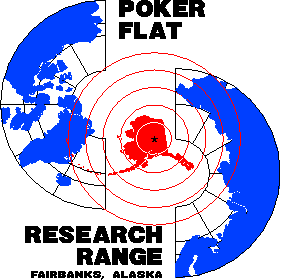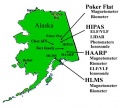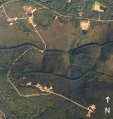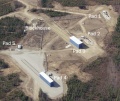PFRR
Da Ufopedia.
| Questa voce ha bisogno di essere tradotta. |
The Poker Flat Research Range (PFRR) is a launch facility and rocket range for sounding rockets in the U.S. state of Alaska, owned and operated by the University of Alaska Fairbanks (UAF) Geophysical Institute since 1968. The world's largest land-based rocket range, it is situated on a 5132 acre site located approximately 30 miles (50 km) northeast of Fairbanks and is operated under contract to the NASA Wallops Flight Facility. Since its inception PFRR has been closely aligned and funded by the Defense Threat Reduction Agency and its predecessor, the Defense Nuclear Agency (DNA). Other range users include the United States Naval Research Laboratory (NRL), the Air Force Geophysics Lab (AFGL) and a number of Universities and research laboratories. More than 1,700 launches have been conducted at the range to study the Earth's atmosphere and the interaction between the atmosphere and the space environment .[1] Areas studied at PFRR include the aurora, plasma physics, the ozone layer, solar proton events, Earth's magnetic field, and ultraviolet radiation.
Indice |
History
The PFRR originated from University of Alaska auroral research in the 1920s. Sounding rockets were first used for this in 1946. In 1968 the UAF Geophysical Institute leased the land that became the PFRR from the state of Alaska, and the range's facilities were initially completed in 1972 with leadership and vision from Dr. T. Neil Davis. Neil Davis asked Neal Brown to be PFRR's first supervisor and Brown directed the facility from 1971-1989. Construction of new facilities was undertaken in the 1990s with a $30 million grant provided by Congress. Refurbishment of older facilities is an ongoing project.[2]
Facilities
Support facilities at Poker Flat Research Range include five launch pads, including two optimized for severe weather operations capable of handling rockets weighing up to 35000 lb. Launches have attained an apogee of up to Template:Convert and impact on the Arctic ice shelf over 1100 mi downrange. Range facilities include an administrative facility, a blockhouse, several rocket assembly buildings, a 2-story science observatory, and a payload assembly building. Three S band antennas are used to collect telemetry, and a C band radar is used for tracking rocket payloads in-flight.[3]
Poker Flat's scope of activities is ever changing with the recent addition of SRI's PFISR (Poker Flat Incoherent Scatter Radar) phased array antenna and the recent purchase of several Insitu UAV/UAS (Unmanned Aerial Vehicle/Unmanned Aerial System).
The Alaska Ground Station (AGS) together with the Honeywell Datalynx PF1 supports PFRR operations of many NASA and other nation's spacecraft including Aqua, Aura, Terra, and Landsat 7 with S band and X band services. PF1 is part of the Earth Observing System Polar Ground Network (EPGN), along with the Alaska Ground Station (AGS). Other ground stations in the EPGN include the Svalbard Ground Station (SGS), the Kongsberg-Lockheed Martin ground station (SKS), and the Svalsat ground station (SG3) in Norway.
Galleria immagini
Sounding rockets
- Arcas
- Astrobee
- Black Brant
- MIM-23 Hawk
- MGR-1 Honest John
- Javelin
- Loki
- Nike
- Rocketsonde
- Sandhawk
- MGM-29 Sergeant
- Strypi
- RIM-2 Terrier
- TE-416 Tomahawk
See also
- Other Alaskan astronomical research stations: HIPAS-HIgh Power Auroral Stimulation, HAARP-High-frequency Active Auroral Research Program
References
Related works
- 2006. Rockets Over Alaska: The Genesis of Poker Flat. By Neil Davis. Alaska-Yukon Press.
- 1980. Poker Flat Research Range: Range Users' Handbook. By Merritt Helfferich, Neal Boyd Brown, and Peggy Dace. Geophysical Institute: University of Alaska Fairbanks.
External links
- Poker Flat Research Range official website
- Poker Flat at Encyclopedia Astronautica.
- Aurora rocket article from USA Today.
- Svalsat official website
- Kongsberg Satellite Services AS official website











